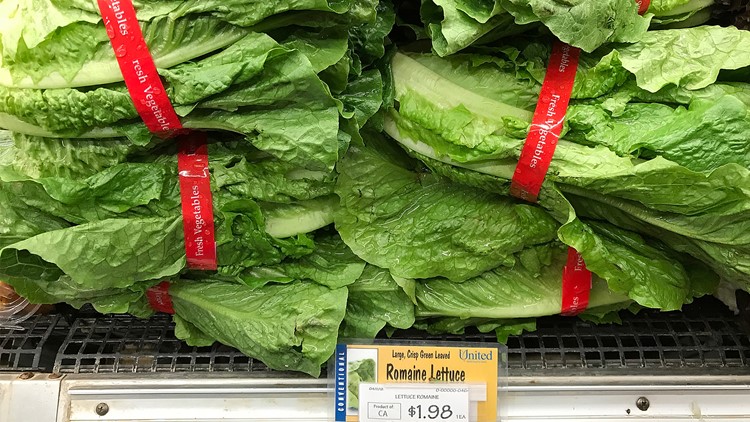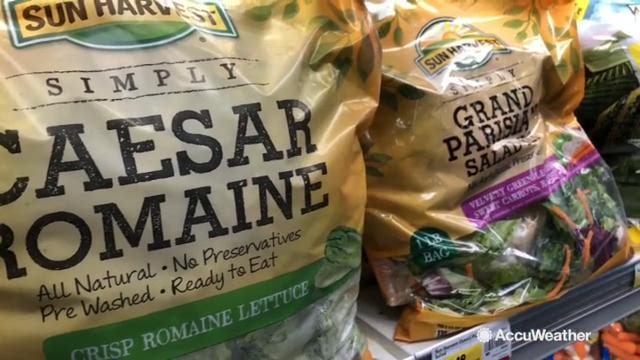The romaine lettuce multi-state E. coli outbreak month, has now sickened 28 more people in four more states, the Centers for Disease Control said Wednesday.
That brings the total to 149 victims in 29 states, but there have been no additional deaths. News of the first person to die from this outbreak was reported last week.
The problem stems from bacteria-tainted romaine lettuce grown near Yuma, Ariz.
This is the largest such outbreak in the U.S. in a dozen years.
Sixty-four individuals have been hospitalized, including 17 with kidney failure, according to the CDC. The sick people range in age from 1 to 88 with a median age of 30. Two out of three have been women.
The Arizona Department of Health Services told consumers in April to avoid eating any product that contains romaine lettuce. That includes whole heads and hearts of romaine lettuce, chopped romaine, and salads or salad mixes that contain romaine.
"Of the 112 people interviewed, 102, or 91%, reported eating romaine lettuce in the week before their illness started," the CDC wrote on its website Wednesday. "This percentage is significantly higher than results from a survey of healthy people, in which 46% reported eating romaine lettuce in the week before they were interviewed."
The number of people infected by the romaine lettuce could still increase, due to cases after April 17. That's because of the time that passes between when a person gets sick and when it's reported, a process that takes an average of two to three weeks, the CDC added.
Investigators said last month that they are looking at "dozens" of farms as possible sources.
KEEP YOURSELF SAFE: What you need to know about E. coli
"You're looking at more of a web," Dr. Stic Harris, director of the U.S. The Food and Drug Administration's Coordinated Outbreak Response and Evaluation Network, said at the time. "We're trying to figure out where all of those are coming from and ideally, we’d like to get those mapped out and find convergence someplace to identify some specific cause and we’re not there yet. We may not get there."
Federal officials have warned the public not to eat any romaine lettuce -- whole heads, hearts, chopped, organic or baby -- unless they can confirm it's not from Yuma. For example, Salinas, Calif., is also a big romaine-producing area. People also should avoid salad mixes that include romaine.
This strain of bacteria, called E. coli O157:H7, produces Shiga toxin, according to the CDC. It can produce STX1 and STX2, but those that produce only STX2 -- which is what's happening with this outbreak -- tend to cause more severe illness.
People who contract Shiga toxin-producing E. coli get sick an average of three to four days after they've swallowed the tainted food, the CDC said. The common symptoms are diarrhea, which often is bloody; severe stomach cramps; and vomiting. The majority of people get better within a week, though more severe cases last longer
The bacteria can spread through ruminants, animals like cattle, sheep, goats, buffalo, elk, and deer; water; the environment and people, Dr. Robert Tauxe , director of CDC’s Division of Foodborne, Waterborne, and Environmental Diseases, said previously.
The only source found for the outbreak so far is Harrison Farms, which supplied only the whole-head romaine lettuce to a correctional facility in Alaska. Eight people in that state got sick. Those heads were harvested between March 5 and 16 and are past their 21-day shelf life.
The CDC said the current outbreak is unrelated to the multi-state outbreak of E. coli in leafy greens in November and December, because the two strains of E. coli O157:H7 bacteria have different DNA fingerprints.
Federal officials first warned of the problem in April after people started getting sick from greens they ate March 22 to 31.
In 2006, a STX2-only E. coli outbreak from spinach grown in Salinas, Calif., sickened more than 200 people, Tauxe said. In that case, the E. coli was traced back to a grower located near a stream not far from a cow pasture. Cattle wandered into the stream and wild pigs were found running back and forth.




